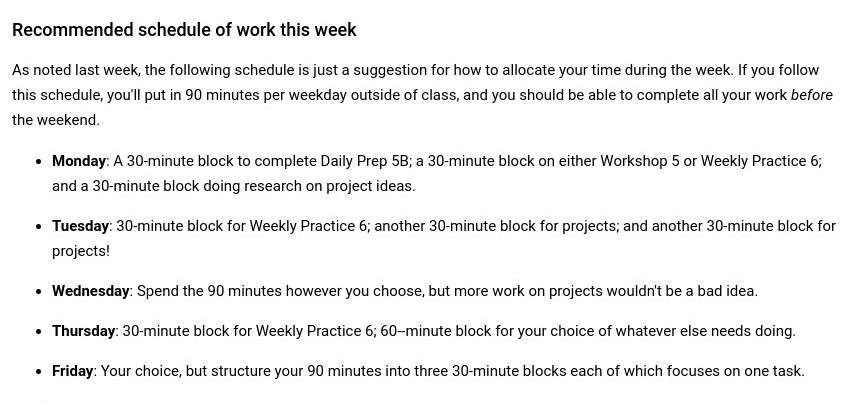Committing to communication

Here are three points I've recently made about the workload dilemma in US higher education right now:
- Although it's entirely possible that students during the pandemic have had to do more academic work in their courses than pre-pandemic, and although we faculty should be mindful of this, the perception of "workload" is not necessarily just about quantity.
- Instead, it's likely quantity plus a complex combination of causes coming from different kinds of "load" – emotional load and cognitive load particularly – which many of us faculty are either not paying enough attention to, or have done a poor job in preparing our students to handle. Or both.
- And the primary responsibility for doing something about this arrangement of "load" falls on us, the faculty, like it or not.
The next logical question is, what do we do about it? Well, I can think of at least three things that we should not do. We should not make superficial changes to our courses with the intent on rolling them back once "things are back to normal"; for example cutting out this paper or that project may help students a little now, but it's not a long-term solution. We should also not simply lob resources and advice at students without walking alongside them; for example handing each student a free copy of the Getting Things Done book and telling them to read the first four chapters and put them to use, with the thought that this will fix their time management problems. That may be well-intentioned but it's roughly the same as having students watch videos before class without any guidance on how to learn from them. And it should, but sadly does not, go without saying that we can't just tell students to buck up and work harder. (And then go on Twitter or /r/professors to "vent".)
Instead, the more I think about this question of what do we do about it, and the more I deal with this question in real life with my own students, the more I think the answer is a lot simpler than we think. I think we need to commit to communicating. Let me explain.
I wrote a lot in the first chapter of my book on flipped learning about my early crushing failures in trying to implement that framework with real, live students. Somewhere in there, I wrote that most of my failures in teaching have really been failures in communication. In those early flipped courses, for example, I never communicated clear, measurable learning objectives to students, so they had to bear the unnecessary load of not only learning the material but also figuring out what it is they were supposed to be learning. Once I started giving the learning objectives to students in advance of their class work — and split them into "Basic" and "Advanced" lists to let them know what not to learn before class — my students were, overnight, a lot happier. Same work; less load. Also in those early courses, I was getting crushed by negative student ratings, and at some point it dawned on me that if I gathered data on student perceptions before the end of the semester, I could make course corrections early enough to solve these problems before they were official. And eventually, flipped learning became my standard practice and my students are now perfectly fine with it, even praise it, even in a pandemic.
All of these were improvements in communication. All of them look stupidly basic in retrospect, just Human Relationships 101 stuff. But human relationships are hard; it's most of what makes teaching hard. We all need to work on this, and we all need to commit to communicating with students better. And I am convinced this will solve a lot of problems that we currently label as "workload" problems.
Example 1: Taking care to write clear, measurable learning objectives for each lesson in each of our courses, and then making those clear to students, will reduce load in a number of different ways. For students, the learning objectives constitute both a to-do list and a not-to-do list. The learning objectives put productive constraints around the learning environment to keep students from straying off into territory that will suck away their energies and time. They give students the answer to the question, Why is this relevant? and thereby build motivation. And for us, learning objectives do much the same thing. If we align class preparation and assessments with a clear line-of-sight to the learning objectives, it will be a hedge against us making exams that are unfocused and too long, activities that don't lead anywhere, etc. They are, ultimately, workload-reducers that focus energy on the right things. And all of us can start this right away — for your next class, write down that list and send it to your students.
Example 2: I also mentioned mid-semester evaluations above. Good communication is two-way. It's the middle of the semester (or almost) for a lot of faculty right now. Make up a short informal survey and give it to your students, explaining that as we enter the second half of the term, like a good sports team we want to make productive halftime adjustments; and explain that you want to do this from the students' point of view, so you need their input. These mid-semester surveys do three things to lighten the actual load on students. First, they gather valuable intel for you, to surface potential issues that you can then address, and once addressed, a pain point for at least some students has been relieved. Second, they open the door for one-on-one communication with students; if you let students give their names, you can follow up with them, and personal communication is a great emotional load-reducer. Third, maybe most importantly, they communicate to students that they are seen and heard. It's difficult to overstate the relief that this conveys.
Example 3: One of the sources of "workload" I identified in an earlier post was a lack of experience with managing work itself, and this is not the students' fault, because nobody has ever taught them how to do it. This is an opening, a "market" if you will, for high-quality communication — simply being clear to students about how much time to spend on things, and when and how to spend it. I started doing this a few years ago with an upper-level class, by giving them a weekly suggested schedule for work that sets aside 90 minutes a weekday (appropriate for a 3-credit course) broken into three 30-minute sprints. This is what it looks like for my current Modern Algebra class:

(Direct link here) Not every student chooses to follow this, but some do, and it's the first time anybody ever suggested that 90 minutes a day in three 30-minute bursts is a good way to work on a class — as opposed to waiting until Saturday to do anything and then doing a 6-8 hour slog (only the first 1-2 of which are productive). I think it communicates in a concrete way that I respect their time, care a little about their well-being, and want them to succeed. It also helps that I also organize my work on their course in exactly the same way – 90 minutes every morning, cut up into three pomodoros. So this is not only good communication, it also addresses the other problem with "workload" (lack of training and experience in managing complex commitments) in a head-on way.
Above all, the biggest step we can make in better communication with students is to adopt the mindset that students are people with whom we can and should communicate in the first place. It's so easy to objectify students and lump them all into the category of "other". Much of the complaining I see on the internet veers into this territory, and I think being online makes this harder to avoid. But if you change your viewpoint and see students as collaborators with whom you are working to co-create something of equal value to all of us, then communication not only becomes easier, it becomes more urgent, and more effective in helping students carry their loads.


